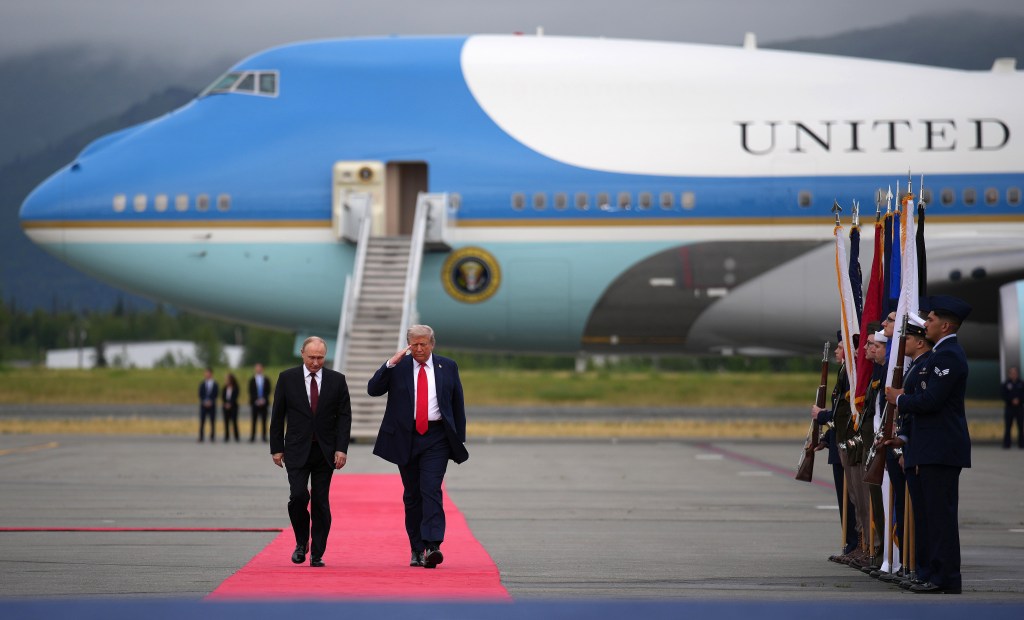
Trump and Putin initially planned to start discussions with a one-on-one conversation, joined only by their translators, but those plans were scrapped in favor of a broader meeting: Secretary of State Marco Rubio and Trump’s special envoy Steve Witkoff joined from the American side, Russian Foreign Minister Sergey Lavrov—donning a Soviet Union-branded sweater—and Putin’s longtime foreign policy adviser Yuri Ushakov from the Russian side. Discussions lasted under three hours, and, although Trump described the day’s events on Truth Social as “very successful,” no deal was announced or terms outlined during Trump and Putin’s subsequent news conference. Both leaders declined to take questions from reporters, and Putin flew home to Russia shortly after.
So what was discussed? According to multiple outlets, Putin presented Trump with a similar deal to the one he offered Witkoff last week: Peace would require that Ukraine withdraw all its forces from its eastern Donbas region, effectively ceding authority of the territory to Russia indefinitely. (While Russian forces currently occupy the majority of the Donbas, Ukraine’s defensive line has held a grip on some land.) In exchange, Putin would agree to pause fighting along the current front lines, sign a written statement pledging not to attack Ukraine (again), and consent to U.S.-provided security guarantees for Ukraine.
Ukrainian President Volodymyr Zelensky has previously publicly rejected such a deal, opposing any arrangement that would allow the Kremlin to divvy up and reign over large sections of Ukraine. “If we withdraw from the Donbas today—our fortifications, our terrain, the heights we control—we will clearly open a bridgehead for the Russians to prepare an offensive,” Zelensky warned last week. Maria Snegovaya, a senior fellow at the Center for Strategic and International Studies, noted in a summit preview last week that “Ukraine currently controls about 25 percent of the [Donbas’] Donetsk region,” and that “ceding such a large portion of its own unoccupied territory (even in exchange for other areas) would be unprecedented.”
As Trump flew back to Washington, D.C., following the summit, he called Zelensky and European leaders to provide an update on his latest discussions with Putin. According to an unnamed source with “direct knowledge” who spoke to Axios, the call lasted more than 30 minutes and “was not easy.” The president’s position, according to the source, is that a fast peace deal is preferable to a ceasefire, and—with Putin willing to do so—ending the war is up to Zelensky. “We, I think, are close to a deal, but I don’t like saying it,” Trump told Fox News’ Sean Hannity on Sunday, adding that, while “many things can happen,” he believes Putin “would like to solve the problem.”
“Now,” he added, “it’s really up to President Zelensky to get it done.”
The Ukrainians, meanwhile, maintain that a ceasefire is a necessary prerequisite for any lasting peace deal and that, without sufficient security commitments, Putin will invade their country again in the future. This is also the view of many European allies who rallied behind Ukraine in the run-up to the Friday summit, most of whom will join Zelensky at the White House later today for a follow-up conversation—his first in-person visit since February, when a heated conversation with Trump and Vice President J.D. Vance led to a swift and bitter departure. “The Europeans are very afraid of the Oval Office scene being repeated,” Dominique Trinquand, the retired French general who previously served as head of France’s military mission at the United Nations, told CBS News. “So they want to support Mr. Zelensky to the hilt.” NATO Secretary General Mark Rutte, European Commission President Ursula von der Leyen, French President Emmanuel Macron, British Prime Minister Keir Starmer, Italian Prime Minister Giorgia Meloni, Finnish President Alexander Stubb, and German Chancellor Friedrich Merz are all expected to be in attendance.
But Trump may have previewed his approach to today’s meeting in a Truth Social post late last night. “President Zelenskyy of Ukraine can end the war with Russia almost immediately, if he wants to, or he can continue to fight,” he wrote. “Remember how it started. No getting back Obama given Crimea (12 years ago, without a shot being fired!), and NO GOING INTO NATO BY UKRAINE. Some things never change!!!”
Zelensky responded about an hour later in a post on X. “I have already arrived in Washington,” he wrote, adding that he’s grateful for the White House invitation. “We all share a strong desire to end this war quickly and reliably.” However, he noted: “Of course, Crimea should not have been given up then, just as Ukrainians did not give up Kyiv, Odesa, or Kharkiv after 2022. Ukrainians are fighting for their land, for their independence.” For Zelensky, a ceasefire is the priority, yet continuing to fight remains preferable to Russia taking Ukraine’s eastern territory, including fully developed cities.
Meanwhile, Putin made clear on Friday that, short of gaining Russia a large section of Ukraine through diplomacy, he is willing to continue pursuing alternative means toward his ends. While on the tarmac next to Trump shortly after arriving in Alaska, Putin was asked by a reporter, “Will you stop killing civilians?” The Russian leader responded with a shrug and acted as if he had not heard the question, tapping his ear ironically.
















